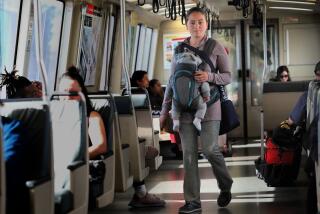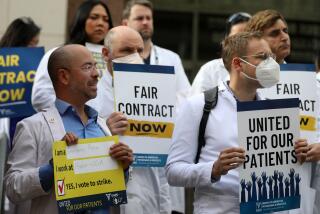Firms Pay Workers to Get Them Off the Road : Commuting: A city code will soon require San Diego businesses to reduce the number of employees who drive to work alone during peak hours. Workers are responding to many of the incentives.
- Share via
When Ibby Gaunt was hired three weeks ago by San Diego Trust & Savings, she was offered an incentive to use public transportation. If she took the trolley or bus to work, she would be reimbursed 125% of the cost for a monthly pass.
Gaunt took the offer and now rides the trolley daily, commuting from her home in Rancho San Diego to the Gaslamp stop at 5th Avenue and C Street. Gaunt, 31, a payroll assistant at the Trust & Savings main office on Broadway, receives $56.25 a month from the bank for the purchase of a trolley pass, which costs $45 a month.
The bank is one of a growing number of employers in downtown San Diego to offer its workers incentives to use alternative means of transportation to get to work. Apart from doing its share to ease traffic congestion and air pollution, companies benefit monetarily by reducing the cost of providing parking for employees.
About half of Trust & Savings’ 500 downtown workers take the bus, trolley or a car pool to work, which means fewer employees need parking in expensive downtown lots. San Diego Trust & Savings’ downtown branch has no parking of its own.
While the bank has for several years reimbursed personnel for the use of public transportation, other businesses are only now initiating similar incentive programs. Much of the new emphasis is the result of a city ordinance passed in September that requires businesses to reduce the number of employees who drive to work alone during peak commuter hours.
The ordinance, which goes into effect Monday, also requires companies that employ 15 people or more to provide incentives for employees to take the bus, trolley or car pools to work. Businesses that do not submit transportation management plans may be issued misdemeanor citations or assessed fines. The intent of the measure is to reduce air pollution and traffic congestion.
The Downtown Traffic Management Assn. was formed a year ago by public and private employers to address traffic concerns. The group works with businesses to tailor specific traffic management plans to individual companies, and shares parking and transportation information.
The association now has 39 members and is continuing to grow, said Alina Kulikowski, executive director of the group. The organization includes state, federal and private employers. About 50 such organizations are in existence across the country, compared to 30 a year ago.
“We are trying to manage a demand for transportation and trying to funnel it away from driving alone in cars,” Kulikowski said. “It’s a very tough thing to do because you are trying to change behavior. You are not going to change behavior by throwing money at it; you are going to change behavior by getting business involved.”
For employers, the benefits are obvious, Kulikowski said. For example, a company that employs 50 people will usually spend about $50,000 a year to provide parking, based on average downtown prices. If half those employees are instead subsidized for cheaper public transit, the company will save $15,000 to $20,000 a year, she said.
“Working with the CEOs, that’s the key right there,” Kulikowski said. “Once the CEO says, ‘I like this, it’ll save me money,’ he’ll do everything within reason to get his employees to do it.”
For the worker, not driving to the job means less money spent on gas, less on parking if not provided by the employer, less wear and tear on the car and less aggravation from waiting in traffic snarls.
“People who do not drive to work tend to be less stressed, tardy or absent,” Kulikowski said. “If you add that, any way the employer looks at it they are saving money because they are improving job productivity.”
Danelle Ibach, San Diego Trust & Savings’ assistant vice president, said the bank’s employees who use public transportation are more dependable than those who drive alone. The bank also has a competitive advantage in that it is able to more easily recruit people by offering transportation incentives, Ibach said. Costs are cut in subsidizing a monthly trolley pass, at about $45 a month, instead of parking, which can run as high as $175 a month.
At Solar Turbines on Pacific Highway, about 11% of its 1,700 workers are in car pools, use the bus or take the trolley, a company spokesman said. That figure is double what it was nine months ago, when efforts at traffic management were initially begun. Workers who car-pool are offered preferred parking at the company’s adjacent lot. Bus or trolley riders are reimbursed the full amount of a monthly pass, plus $20.
San Diego city employees who work downtown are offered two-for-one trolley passes, a 75% reimbursement for riding the bus and free parking for car-poolers, according to Kristi Berg, deputy director of the transportation demand management division. As a result of these incentives, about 46% of all downtown city workers now use the bus, trolley or car pools to get to work.
About half of all downtown county employees are allowed to work four-day weeks as part of the county’s effort to ease traffic congestion.
At the state level, the state Transportation Department is offering $10 million to help California employers buy vans for those willing to participate in a ride-sharing program.
When Kulikowski, 24, stepped into her position with the downtown association in June, she decided to practice what she would preach. So she sold her car, moved downtown and now uses the bus and trolley to get around.
“If you ask your average person how to ride the bus, they’d say, ‘I don’t know how to get a schedule.’ If you ask them what you do once you get on a bus, they say, ‘I don’t know, do I get a token? Can I get change?’ Your average downtown worker does not know that,” Kulikowski said.
A survey by Commuter Computer that was completed in September listed errands, child care and company business as the biggest reasons for not taking the bus, trolley or car pools. Those concerns are being targeted by the transportation group.
More to Read
Sign up for Essential California
The most important California stories and recommendations in your inbox every morning.
You may occasionally receive promotional content from the Los Angeles Times.










